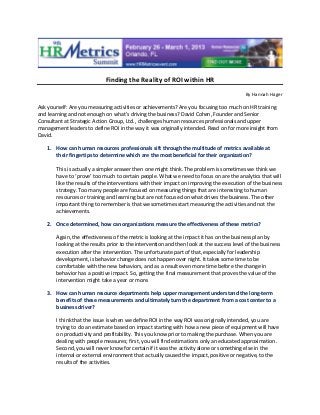
Finding the Reality of ROI within HR
- 1. Finding the Reality of ROI within HR By Hannah Hager Ask yourself: Are you measuring activities or achievements? Are you focusing too much on HR training and learning and not enough on what’s driving the business? David Cohen, Founder and Senior Consultant at Strategic Action Group, Ltd., challenges human resources professionals and upper management leaders to define ROI in the way it was originally intended. Read on for more insight from David. 1. How can human resources professionals sift through the multitude of metrics available at their fingertips to determine which are the most beneficial for their organization? This is actually a simpler answer then one might think. The problem is sometimes we think we have to ‘prove’ too much to certain people. What we need to focus on are the analytics that will like the results of the interventions with their impact on improving the execution of the business strategy. Too many people are focused on measuring things that are interesting to human resources or training and learning but are not focused on what drives the business. The other important thing to remember is that we sometimes start measuring the activities and not the achievements. 2. Once determined, how can organizations measure the effectiveness of these metrics? Again, the effectiveness of the metric is looking at the impact it has on the business plan by looking at the results prior to the intervention and then look at the success level of the business execution after the intervention. The unfortunate part of that, especially for leadership development, is behavior change does not happen over night. It takes some time to be comfortable with the new behaviors, and as a result even more time before the change in behavior has a positive impact. So, getting the final measurement that proves the value of the intervention might take a year or more. 3. How can human resource departments help upper management understand the long-term benefits of these measurements and ultimately turn the department from a cost center to a business driver? I think that the issue is when we define ROI in the way ROI was originally intended, you are trying to do an estimate based on impact starting with how a new piece of equipment will have on productivity and profitability. This you know prior to making the purchase. When you are dealing with people measures; first, you will find estimations only an educated approximation. Second, you will never know for certain if it was the activity alone or something else in the internal or external environment that actually caused the impact, positive or negative, to the results of the activities.
- 2. I don’t think that measurement alone will move the perception of HR from a ‘cost center’ to a business driver. People have to emotionally feel that the actions that were taken are not worth the risk of living without. If the leaders do not make that emotional, visceral link that these actions provide a benefit to the business, then the result will be that the leader doesn’t wish to make the change of living without that activity. No matter how successful the activity was in positively impacting business results, the leader will not continue to support the initiative. 4. What are some ways that organizations are making themselves more attractive to new and current employees? This question is not related to measurement or workforce analytics but rather to the alignment of the person with the organization. By focusing on the person/organization fit, coupled with investment in the development of people for the improvement of both the person and the business organization, they will be more successful in making the company more attractive to new and current employees. Unfortunately, many organizations cut back significantly on the one action they can take to improve performance – the development of staff – and as a result people are looking to find places they can receive the development opportunities. This is a particular issue with Millennial employees. But the issue of celebration of the culture and alignment of people with the culture is something that cuts across all generations at work. We are doing a lot of work with firms on defining the culture fit by defining the actual (not the aspirational) values of the company and employees are motivated and appreciate management paying attention to what actually exists and moving toward the value set that originally made the company great. David will speak on “The Myth or Reality of ROI in HR” at the 9th HR Metrics Summit in Orlando in February.
